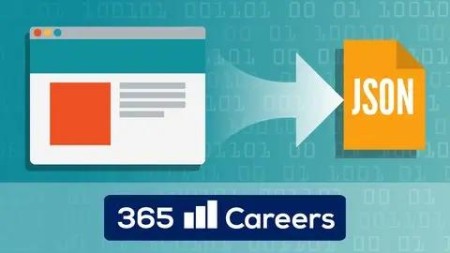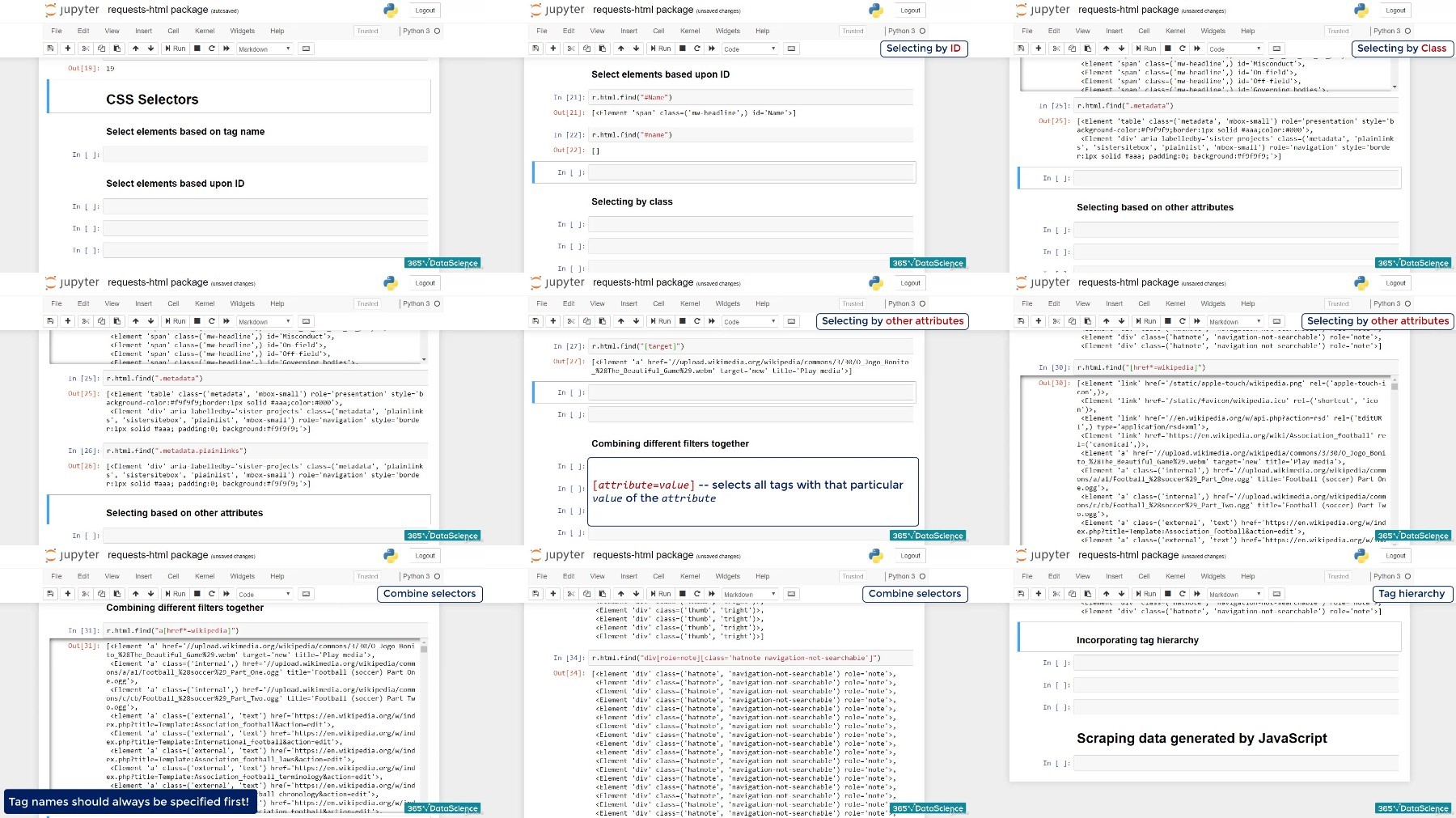Web Scraping And Api Fundamentals In Python

Web Scraping And Api Fundamentals In Python
Last updated 6/2020
MP4 | Video: h264, 1280x720 | Audio: AAC, 44.1 KHz
Language: English | Size: 2.22 GB | Duration: 3h 52m
Learn Web Scraping with Beautiful Soup and requests-html; harness APIs whenever available; automate data collection!
What you'll learn
Learn the fundamentals of Web Scraping
Implement APIs into your applications
Master working with Beautiful Soup
Start using requests-html
Create functioning scrapers
Scrape jаvascript
Familiarize yourself with HTML
Get the hang of CSS Selectors
Make HTTP requests
Understand website cookies
Explore scraping content locked behind a log-in system
Limit the rate of requests
Requirements
Python 3 and the Anaconda distribution
Basic Python knowledge
Curiosity and enthusiasm to learn and practice
Description
Are you tired of manually copying and pasting values in a spreadsheet?Do you want to learn how to obtain interesting, real-time and even rare information from the internet with a simple script?Are you eager to acquire a valuable skill to stay ahead of the competition in this data-driven world?If the answer is yes, then you have come to the right place at the right time!Welcome to Web Scraping and API Fundamentals in Python!The definitive course on data collection!Web Scraping is a technique for obtaining information from web pages or other sources of data, such as APIs, through the use of intelligent automated programs. Web Scraping allows us to gather data from potentially hundreds or thousands of pages with a few lines of code.From reporting to data science, automating extracting data from the web avoids repetitive work. For example, if you have worked in a serious organization, you certainly know that reporting is a recurring topic. There are daily, weekly, monthly, quarterly, and yearly reports. Whether they aim to organize the website data, transactional data, customer data, or even more easy-going information like the weather forecast – reports are indispensable in the current world. And while sometimes it is the intern's job to take care of that, very few tasks are more cost-saving than the automation of reports.When it comes to data science – more and more data comes from external sources, like webpages, downloadable files, and APIs. Knowing how to extract and structure that data quickly is an essential skill that will set you apart in the job market.Yes, it is time to up your game and learn how you can automate the use of APIs and the extraction of useful info from websites.In the first part of the course, we start with APIs. APIs are specifically designed to provide data to developers, so they are the first place to check when searching for data. We will learn about GET requests, POST requests and the JSON format.These concepts are all explored through interesting examples and in a straight-to-the-point manner.Sometimes, however, the information may not be available through the use of an API, but it is contained on a webpage. What can we do in this scenario? Visit the page and write down the data manually?Please don't ever do that!We will learn how to leverage powerful libraries such as 'Beautiful Soup' and 'requests HTML' to scrape any website out there, no matter what combination of languages are used – HTML, jаvascript, and CSS.Certainly, in order to scrape, you'll need to know a thing or two about web development. That's why we have also included an optional section that covers the basics of HTML. Consider that a bonus to all the knowledge you will acquire!We will also explore several scraping projects. We will obtain and structure data about movies from a "Rotten Tomatoes" rank list, examining each step of the process in detail. This will help you develop a feel for what scraping is like in the real world.We'll also tackle how to scrape data from many webpages at once, an all-to-common need when it comes to data extraction.And then it will be your turn to practice what you've learned with several projects we'll set out for you.But there's even more!Web Scraping may not always go as planned (after all, that's why you will be taking this course). Different websites are built in different ways and often our bots may be obstructed. Because of this, we will make an extra effort to explore common roadblocks that you may encounter while scraping and present you with ways to circumnavigate or deal with those problems. These include request headers and cookies, log-in systems and jаvascript generated content.Don't worry if you are familiar with few or none of these terms. We will start from the basics and build our way to proficiency. Moreover, we are firm believers that practice makes perfect, so this course is not so much on the theory side of things, as it adopts more of a hands-on approach. What's more, it contains plenty of homework exercises, downloadable files and notebooks, as well as quiz questions and course notes.We, the 365 Data Science Team are committed to providing only the highest quality content to you – our students. And while we love creating our content in-house, this time we've decided to team up with a true industry expert - Andrew Treadway. Andrew is a Senior Data Scientist for the New York Life Insurance Company. He holds a Master's degree in Computer Science with Machine learning from the Georgia Institute of Technology and is an outstanding professional with more than 7 years of experience in data-related Python programming. He's also the author of the 'yahoo_fin' package, widely used for scraping historical stock price data from Yahoo.As with all of our courses, you have a 30-day money-back guarantee, if at some point you decide that the training isn't the best fit for you. So. you've got nothing to lose – and everything to gain ?So, what are you waiting for?Click the 'Buy now' button and let's start collecting data together!
Overview
Section 1: Introduction to the course
Lecture 1 What does the course cover?
Lecture 2 What is Web Scraping?
Lecture 3 Ethics of Scraping
Lecture 4 Download All Resources
Section 2: Setting up the environment
Lecture 5 Setting up the environment - Do not skip, please!
Lecture 6 Why Python and why Jupyter?
Lecture 7 Installing Anaconda
Lecture 8 Jupyter Dashboard - Part 1
Lecture 9 Jupyter Dashboard - Part 2
Lecture 10 Installing the packages
Section 3: Working with APIs
Lecture 11 API overview
Lecture 12 HTTP requests: GET and POST requests
Lecture 13 JSON: preferred data exchange format for APIs
Lecture 14 Exchange rates API: GETting a JSON reply
Lecture 15 Incorporating parameters in a GET request
Lecture 16 Additional API functionalities
Lecture 17 Creating a simple currency converter
Lecture 18 iTunes API
Lecture 19 iTunes API: Exercise
Lecture 20 iTunes API: Structuring and exporting the data
Lecture 21 APIs: Exercise
Lecture 22 GitHub API: Pagination
Lecture 23 EDAMAM API: Initial setup and registration
Lecture 24 EDAMAM API: Sending a POST request
Lecture 25 Downloading files with requests
Section 4: HTML overview
Lecture 26 What is HTML?
Lecture 27 Structure of HTML
Lecture 28 Syntax of HTML. Tags
Lecture 29 Tag attributes
Lecture 30 Popular tags
Lecture 31 CSS and jаvascript
Lecture 32 Character encoding
Lecture 33 XHTML and code style
Section 5: Web Scraping with Beautiful Soup
Lecture 34 Introduction to the Beautiful Soup package
Lecture 35 Workflow of Web Scraping
Lecture 36 Setting up your first scraper
Lecture 37 Searching and navigating the HTML tree
Lecture 38 Searching the HTML tree by attributes
Lecture 39 Extracting data from the HTML tree
Lecture 40 Extracting text from an HTML tag
Lecture 41 Practical example: dealing with links
Lecture 42 Practical example: Exercise
Lecture 43 Extracting data from nested HTML tags
Lecture 44 Scraping multiple pages automatically
Section 6: Practical project: Scraping Rotten Tomatoes
Lecture 45 Setting up your scraper
Lecture 46 Extracting the title and year of each movie
Lecture 47 Extracting the score of each movie: Exercise
Lecture 48 Extracting the rest of the information
Lecture 49 Dealing with the cast of the movies
Lecture 50 Extracting the rest of the information: Exercise
Lecture 51 Storing and exporting the data in a structured form
Section 7: Scraping HTML tables
Lecture 52 Scraping HTML tables with the help of Pandas
Section 8: Practical projects
Lecture 53 Scraping Steam
Lecture 54 Scraping YouTube
Section 9: Common roadblocks when scraping
Lecture 55 Common roadblocks when Web Scraping.
Section 10: The requests-html package
Lecture 56 Introduction to the requests-html package
Lecture 57 Exploring the capabilities of requests-html for Web Scraping
Lecture 58 Searching for text
Lecture 59 CSS selectors
Lecture 60 Scraping jаvascript
Lecture 61 Scraping jаvascript: Exercise
Lecture 62 Completing 100%
You should take this course if you want to learn how to use APIs,This course is for you if you want to learn how to scrape websites,Anyone who wants to learn how to automate the boring and mundane everyday tasks,Individuals who are curious and passionate about data,The course is ideal for beginners to programming who want to learn Beautiful Soup and requests-html

RapidGator
FileAxa
FileStore
TurboBit
